Then & Now: The RUF Yellow Birds, 1987 and 2017
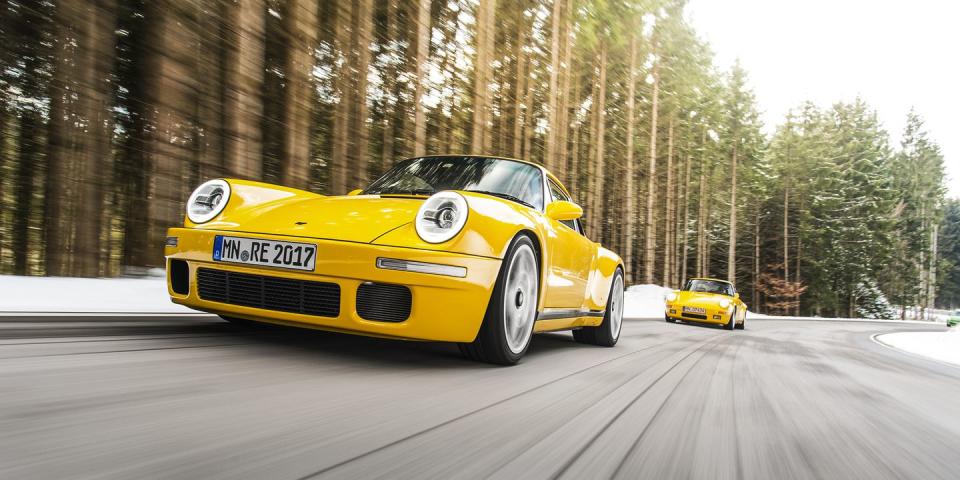
ALOIS RUF IS THE KIND OF MAN who acquires stuff. A handful of Porsche 911 roof panels stacked like the inside of a Russian nesting doll. An office chandelier made from old cylinder jugs. Or the brand-new shell of a 1989 911, tucked in a warehouse next to more classic Porsches than you can easily count. The tub has fenders and doors but no VIN, just a stamped part number on the dash. It has never been built into a car.
“I bought about 35 of these shells from the factory when they were new,” Ruf says. “1989, before production stopped. Then 993s and 964s. We have a few left over.”
Estonia Ruf waves a hand at the tub. “My husband is a man of vision,” she says, chuckling. The line is half serious, half married-couple joke. She delivers it with the kind of ease that comes from giving a lot of tours in a place you have come to know extremely well.
Ruf’s wife helps run the family business. She is thin and cheerful, with frizzy, electric brown hair. You can hear it in her voice, the fact that her husband would if he could buy everything he owns 10 times over, even if it made less business sense than a bagful of monkeys. Because that is what happens when you let an object you love saturate your life, when it supports 65 employees, when it takes your name to 211 mph on the nose of a yellow Porsche-shaped bullet-as of that moment, the fastest production car on earth-on a wet day in the spring of 1987.
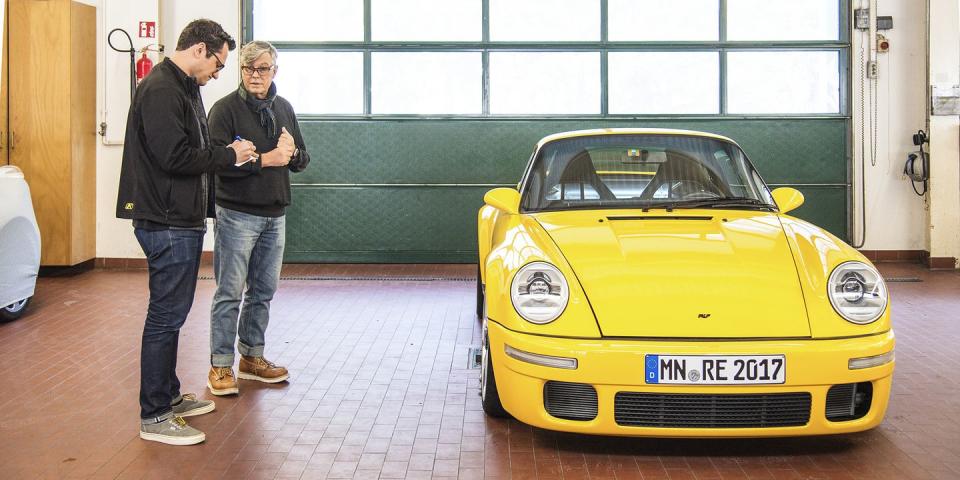
That last moment was a landmark, both for this magazine and for Ruf himself. It occurred in service of an iconic R&T cover story called “The World’s Fastest Cars,” where we took nine vehicles to Volkswagen’s 15.5-mile Ehra-Lessien research oval in Germany. Ruf’s car, which he called CTR, was based on an ordinary Porsche 911. It wore a Ruf badge and Ruf VIN, because the German government had certified him as a manufacturer.
Someone at Ehra-Lessien thought the CTR looked like a yellow bird, flitting across the horizon, and the name stuck. Our drivers were Paul Frère, a Belgian, and Phil Hill, an American. They ran on a track slickened by rain, before the advent of electronic stability control or road cars with significant aerodynamic downforce. Hill was the first American Formula 1 champion, a three-time Le Mans winner, and a brilliant, quirky statesman of American motorsport. Frère was R&T’s European editor, an erudite, multilingual journalist-racer who drove in F1 for Ferrari and who once won Le Mans overall.
Frère and Hill are gone now, but Ruf, 68, still works at the same address. He still famously treats visitors like family. Partly because his shop is in the German farming hamlet of Pfaffenhausen, a mapmaker’s sneeze 60 miles east of Munich. You don’t get there by accident, and certainly not without knowing the story.
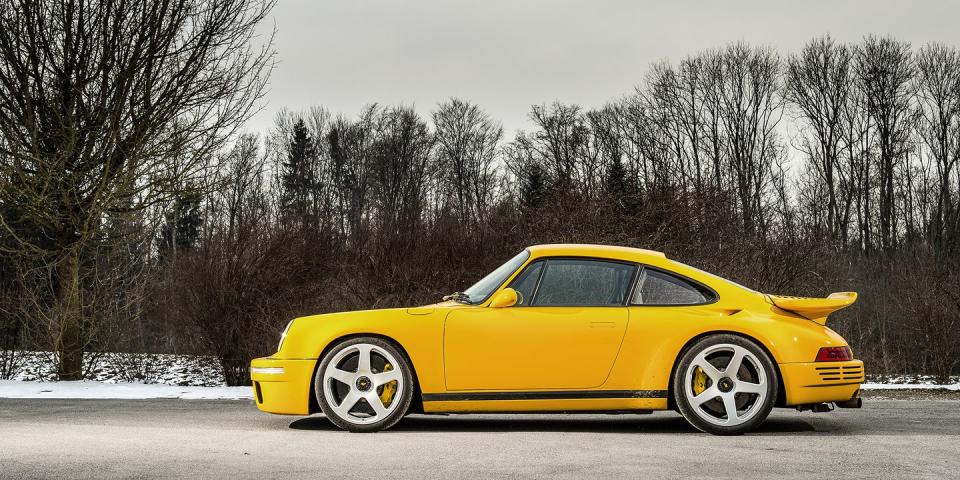
The Yellow Bird wasn’t Ruf’s first car, but its underdog mystique still orbits his work. Most Rufs are based on a contemporary Porsche. Every car from Pfaffenhausen costs well into six figures and is built in a production run that could fit on a city block. Ruf says he engineers his cars with an eye toward mechanical involvement, and that his customers are happy to pay for handmade work with history. Which is partly why, when the original CTR turned 30, he built a new one. He dubbed it CTR 2017 and painted it the same Porsche Blossom yellow. The body was carbon-fiber, over a carbon “punt” frame, with steel subframes. When a nonrunning display version debuted at the 2017 Geneva auto show, it promptly imploded the automotive internet, because the automotive internet loves all things that even hint at the intersection of fast old Porsche and a good story.
Predictably, the new CTR uses a few Porsche parts. Among them is a 700-hp, twin-turbo, water-cooled, 3.6-liter flat-six with roots in the company’s Mezger engine family. (Non-Porsche-nerd translation: Mezger-principle engines powered both the Le Mans– focused 911 GT1 and the first two generations of 911 GT3. They’re named for Hans Mezger, the Stuttgart engineer who chiefed their development.)
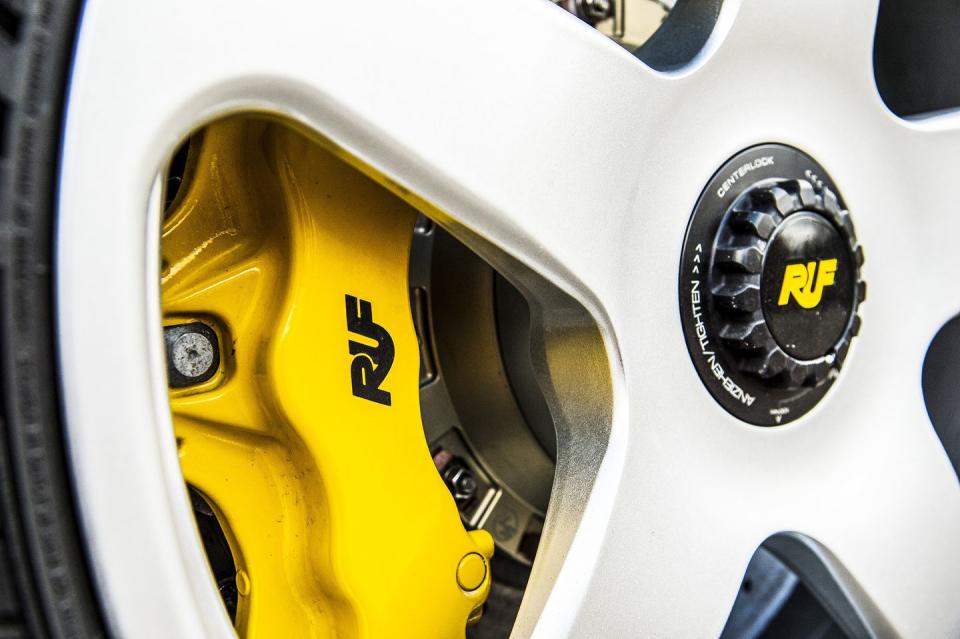
Ruf says his new car will exceed 223 mph. No exterior panel is shared with any Porsche. The 2017 car is 2.8 inches longer in wheelbase than the original Bird, for high-speed stability, and is nearly as wide as the famously hippy 959. There are double A-arms at each corner, with pushrod-operated Sachs dampers. The design features a host of clever styling tricks, from wider doors to broader headlight nacelles. All are aimed at helping the car look remarkably like an old 911 until you park it next to one, at which point it looks alien and ever so slightly larger and nicely funky.
Developing all of this cannot have been cheap. The Rufs politely demur.
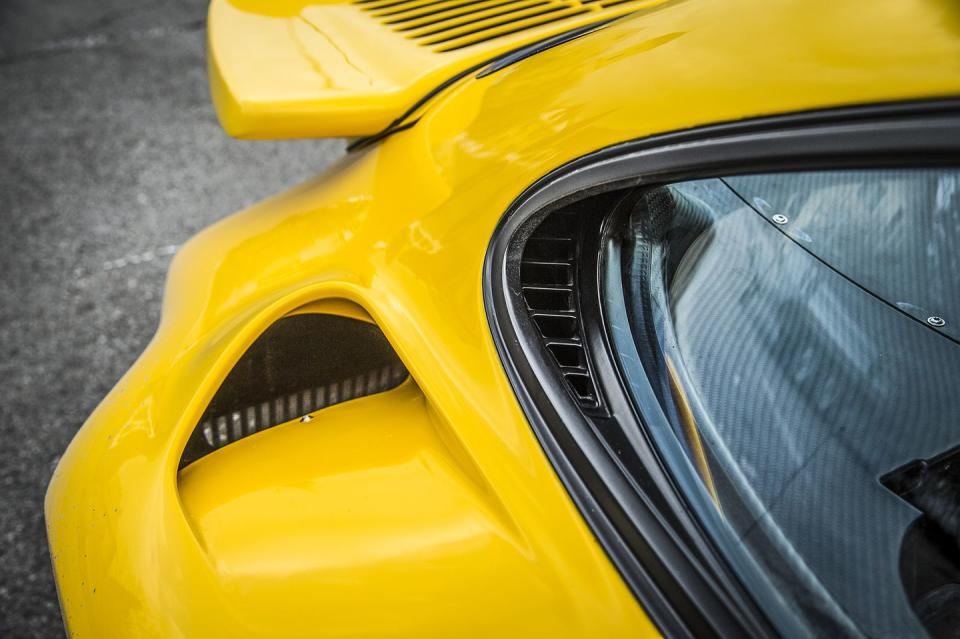
“We didn’t know if anyone would like it,” Estonia says. “You never do. So we figured, maybe, if they don’t, we make just one car for us. But they did.”
Development is ongoing; production starts in late 2018. All 30 build slots, an estimated €750,000 apiece, were sold by the end of the Geneva show. Ruf returned there this year with a running prototype, driven across a snowy Europe. He also shipped in a display example of the car’s frame. It was almost pathologically perfect, with spell-binding weave structure. The tubs are built by Gerg, a Bavarian rm that makes DTM frames for BMW.
“Last year, at the show, people kept asking what it was based on,” Estonia says. “So many people on the stand. And we kept trying to tell them-it’s not based on anything! It’s ours! They didn’t understand. So this year, we could say, it’s based on . . . this.”
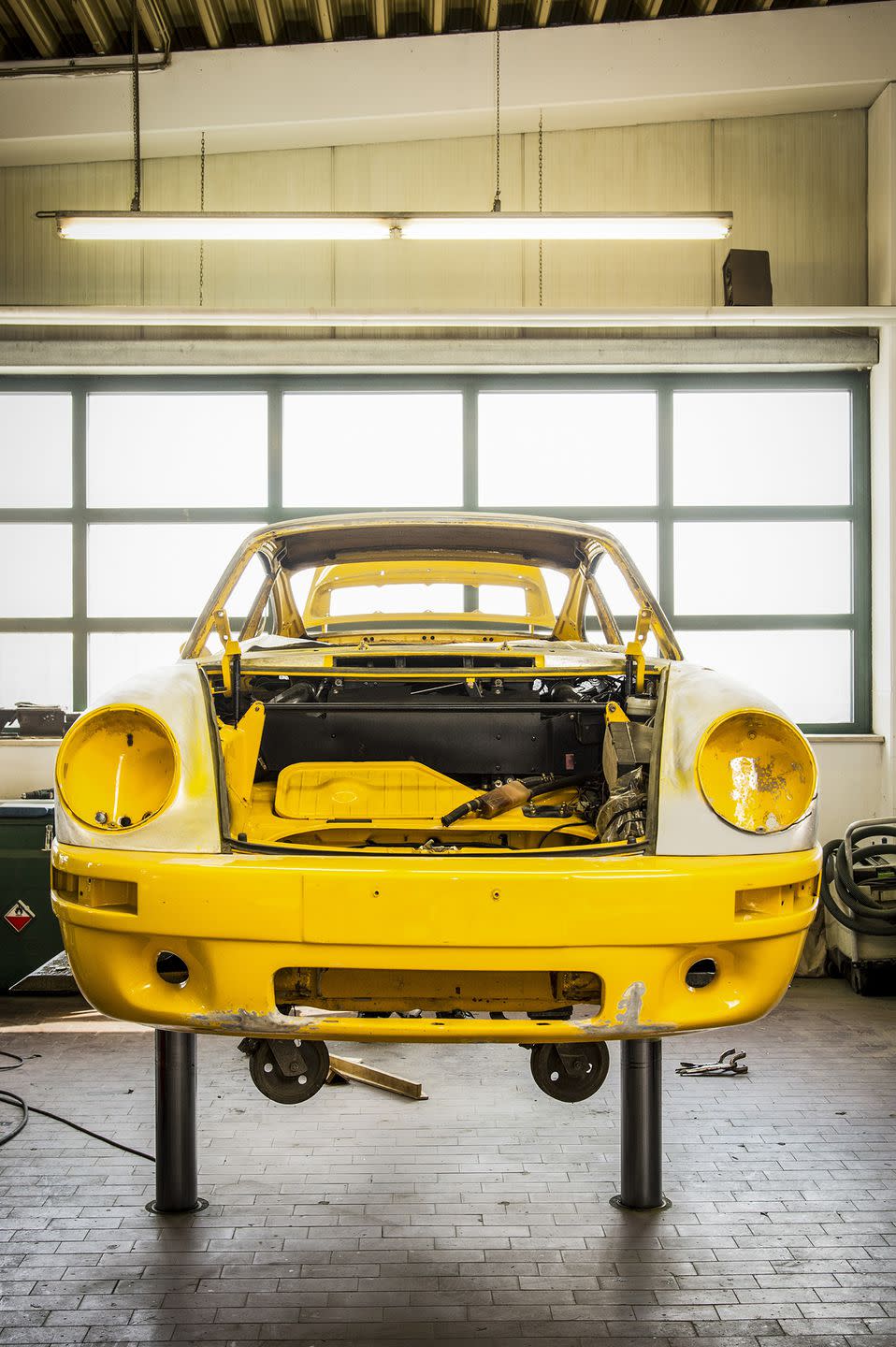
Ruf has built two other generations of CTR since 1987. The most recent, the mid-engine CTR3, is still in production. That car was styled with help from Freeman Thomas, the American designer behind the first Audi TT. Thomas also drew the new CTR. Predictably, he is a longtime Porsche freak-in addition to working for the marque in the Eighties, he co-founded R Gruppe, an American club for hot-rodded early 911s.
Thomas is present the week we visit Ruf. I ask if it was intimidating, muddling with one of the greatest designs in history.
“Not at all. I’ve grown up with this [shape], since the 1960s. In R Gruppe . . . we learned the ins and outs of these cars. We weren’t afraid of them. And Alois was fearless, I think, in the Seventies and Eighties. He just did whatever was needed to make the cars work better.”
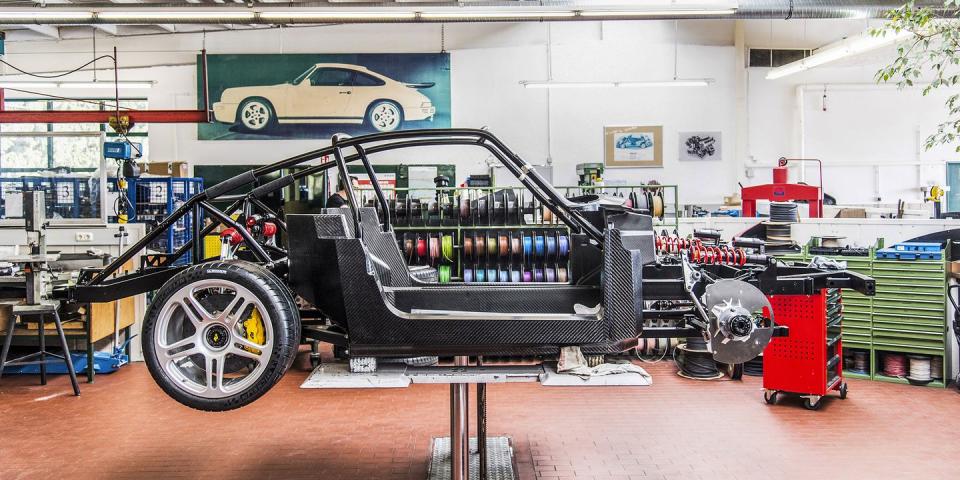
I mention that old Porsches always seem a lot more appealing when you see an owner not taking the car too seriously. Making it their own.
“Design isn’t a one-time thing,” Thomas adds. “You go through it with life-a lot of it is figuring out why you like what you do.”
The shop itself is open and bright, with tiled floors and large windows. Ruf the man was born next door, in house number 19, which still stands. His father, Alois Sr., bought the villa on that corner in 1939. At the time, it also held a small park. After the war, the senior Ruf tore down the park and built a shop. The younger Ruf grew it.
I step into a dyno room with Claudio Schropp, one of Ruf’s technicians. Schropp is young and blond and broad-shouldered, only a few years out of school, with Hazet wrenches and a large blue tool cabinet. He rolls his box around in a kind of walking grin.
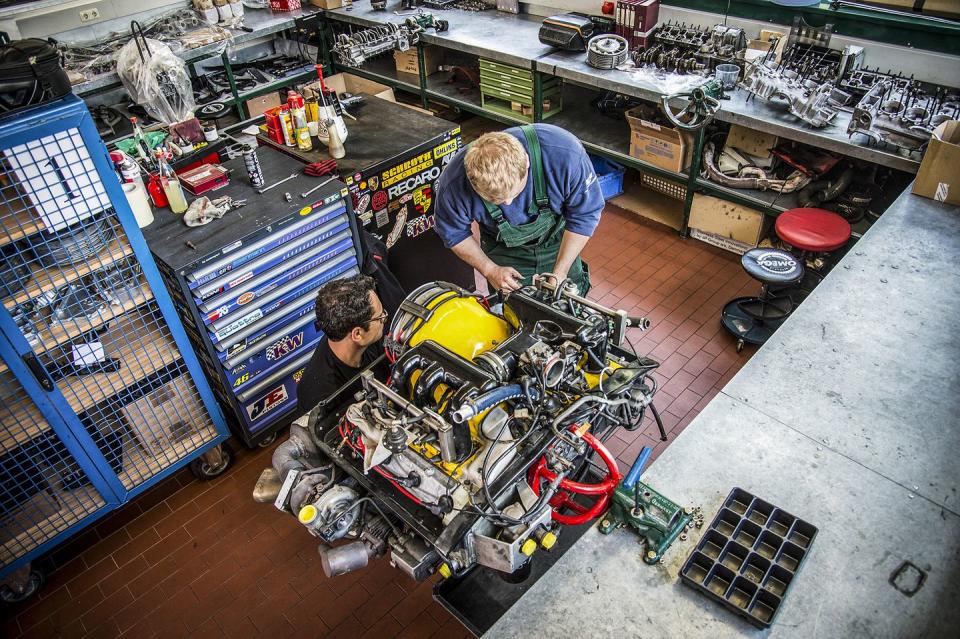
Ruf has two dynos, one for water-cooled engines and one for air-cooled. Schropp spends much of his time on the latter. He does not work on wassergekühlt, he says cheerily, in lumpy English. “Only the old cars. My choice.”
In another life, before becoming a journalist, I was the world’s slowest professional mechanic. So before my visit, I asked Ruf if I could work a little in his shop, to get to know the place. Schropp walks me to the 3.4-liter twin-turbo flat-six of the first customer CTR, a 1987 model owned by an American collector. The car came to Ruf for restoration, and the engine, now in prep for a rebuild, hasn’t been apart since the Eighties. We’re to unbolt the motor from the dyno, move it to the engine department, and pull its turbos and exhaust.
Ruf’s air-cooled dyno was built in 1983. The walls are unfinished clay brick and so close that the equipment doesn’t so much live in the room as wear it like a hat. The dyno operator is separated from the engine by a thick glass window that Ruf salvaged from the demolition of a local bank. The room’s output is now fed through a computer, but the original analog torque gauge is still present. It looks large enough to weigh a cow.
The engine starts with a cough, then snarls into tenor notes in the middle of its range. Factory Porsche turbo engines often go hoarse under load, like a vacuum cleaner. Every Ruf I’ve ever heard has somehow managed to be more operatic.
Schropp breaks out his grin again. “A very nice engine.”
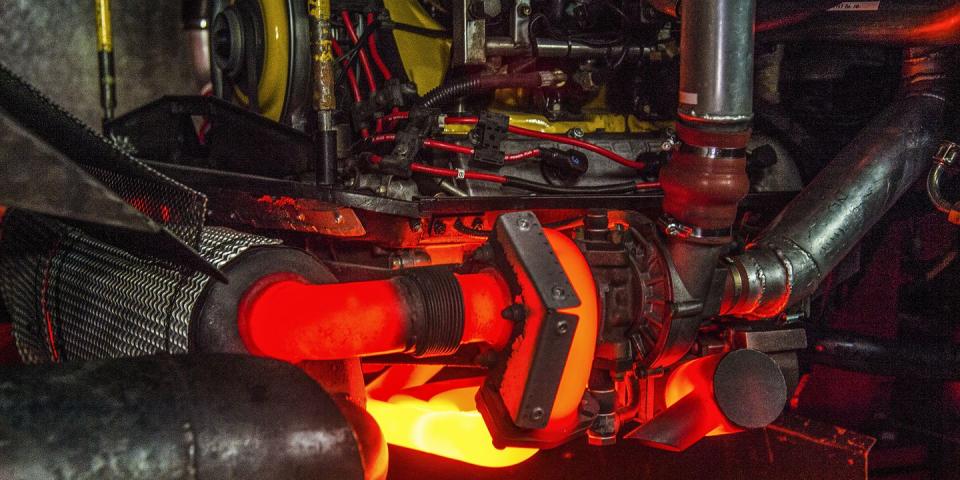
After a few minutes, we let the motor cool. When we come back, I disconnect the intercooler air feed while Schropp starts unhooking fuel hoses. The American’s engine made more than 530 hp at 6000 rpm, he says.
“Every CTR1 engine is a good engine. They always make over 500 hp.” Which sounds like a line, but his shoulders and eyebrows shrug in a way that makes it believable.
We move the motor from a dyno room to a stand in the engine department. Schropp and I work silently for a bit, removing turbo plumbing. Then I spill a few dollops of oil on the floor while unbolting a feed line. Schropp, organizing hardware, chuckles.
“Our boss hates this,” he says, pointing to the spill. He puffs his cheeks and mimes his hands exploding off his head. Kneeling to clean up, I notice that the shop floor is spotless. Even in the dark corners under the benches, where most working shops are filthy.
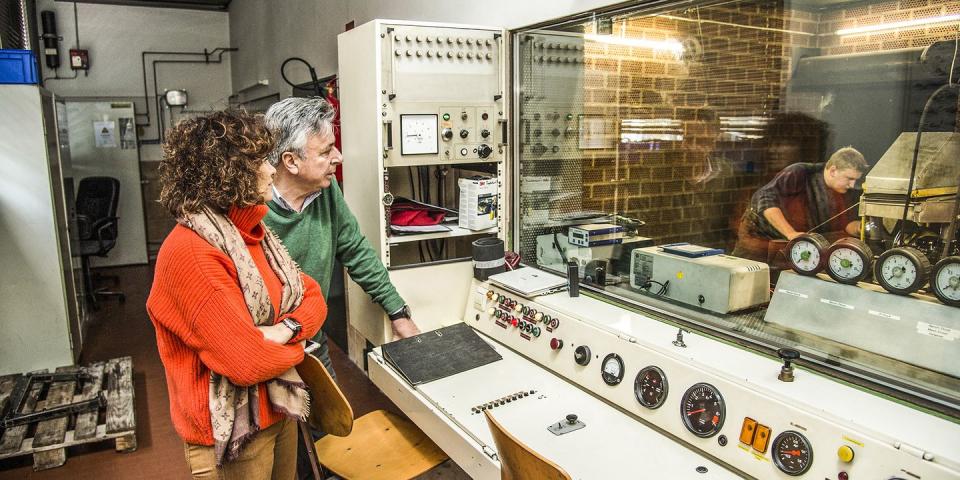
It occurs to me that certain parts of the world will always be quietly satisfying. Like whenever you discover that a famously detail-oriented person is, in fact, attentive to detail.
Later, as I’m putting away tools, Estonia pops into the room. I was impressed by the American engine, I say, given that it had never been apart.
“You know, the 469-hp number that we gave to the press for that car . . . that was a worst-case scenario,” Estonia says. More laughter.
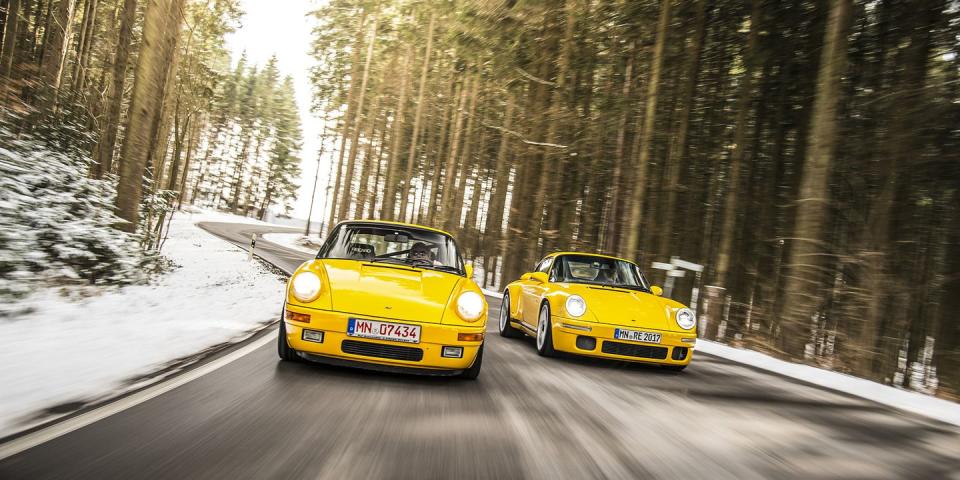
THE PAVEMENT SHINES IN THE VIDEO, obviously wet. Former R&T art director Richard Baron brought a camcorder to Ehra-Lessien. I learn this over dinner at Ruf’s house, a tidy farm near a small river. As Estonia fries schnitzel, Ruf pops a tape into a VHS deck and plops onto the couch. The TV lights up with a German parking lot and a gaggle of Eighties poster cars. A young Peter Egan, joking after a Callaway Corvette blows its engine. Then straight-line testing at Hockenheim. Plus a dozen happy little moments not in print, like when Phil Hill climbs into the trunk of an AMG Hammer on one of Frère’s acceleration runs, to help traction. (“Just give it a little more hell,” Hill says. Then they shut the trunk on him, and Frère lights up the tires.)
One run around the oval left Frère wide-eyed. On the tape, he sits in the Yellow Bird, a soft smile, blinking rapidly. “Dreihundersiebenunddreissig.” Then more German. Ruf translates: “Three hundred and thirty-seven. In the other direction, two kilometers slower.”
Three hundred thirty-seven kilometers per hour is 209.4 mph. More than 7000 rpm in fifth gear. A legend, visibly giddy. (The 211-mph run came with Hill, later, when the track had dried.)
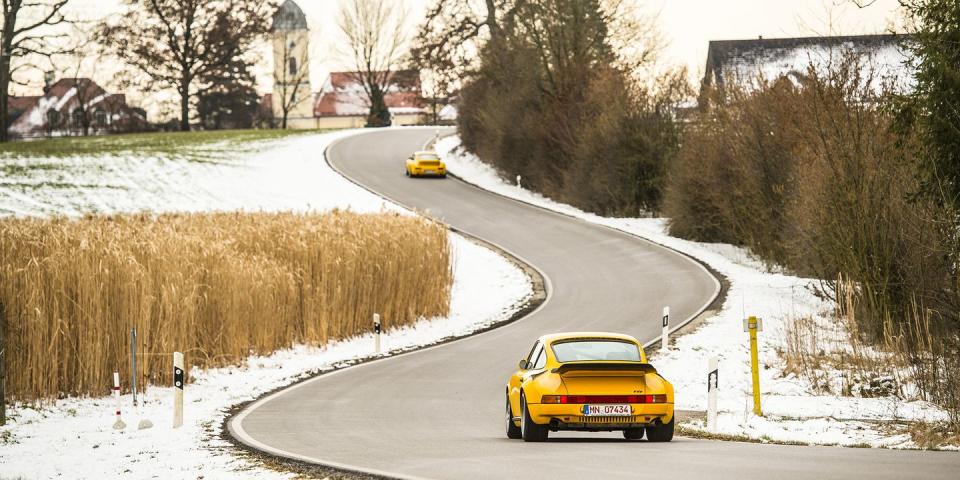
It’s a difficult image to shake, so I decide to not shake it. I let the footage play in my head the next afternoon, when Ruf and I drive the Bird and his new prototype CTR to nearby hills. The weather, Ruf tells me, is what the Germans call “hair dryer”-storms blowing over the Alps, giving clear skies and a dusting of rapidly melting snow. The land is covered in something like lodgepole pines, pin-straight and dense as hairbrush bristles. They block enough of the low winter sun that the road goes dark for long stretches. The contrast makes the cars glow.
We stop for photography at a cluster of small houses. “The car was going to be red,” Ruf says. “All Porsche test cars were then Guards red, because it popped in sunlight. We had it loaded in the paint gun. Yellow was, at the time, environmentally unfriendly. I said, just one car, why not? Then clouds at Ehra-Lessien, and it was the only car at the shoot that looked right on film. Luck.” And the house color was forever set, and that was that.
We came for the new CTR, but Ruf offers to let me drive the old one. I glance at Tom Salt, our photographer, setting up a shot with the 2017 car. Words become difficult.
“I’ll be...a bit?”
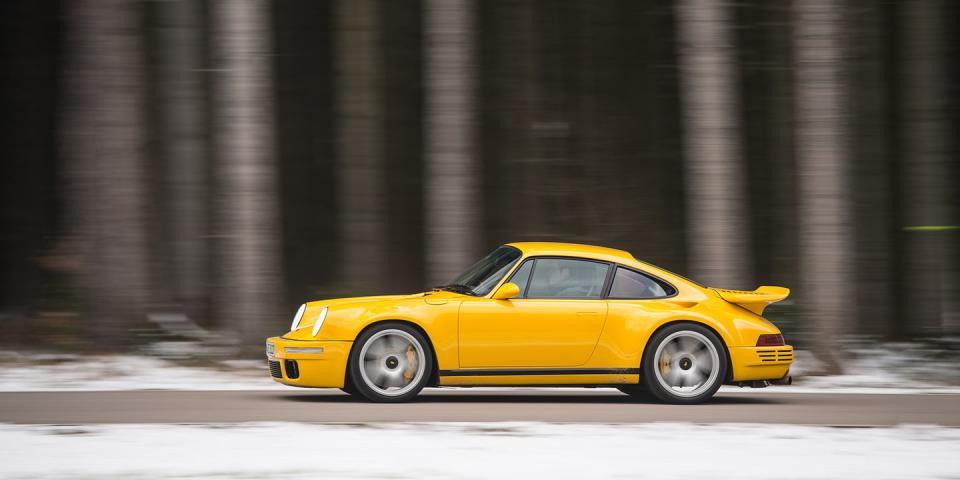
I am gone maybe too long. My head barely clears the dash. The seats are low Recaro shells with harnesses, the same type as in the video. The engine fires on the first crank but is laggy and snorty around town. Small throttle openings at low rpm produce hiccups and surges, so I don’t use small throttle openings. Big throttle gives a one-two beat before the car hurtles off. The cockpit is Eighties 911, comfy but empty: Blaupunkt radio, antenna taped to the windshield. Thin carpet. An integrated roll cage.
The five-speed gearbox is slow, the shifter indifferent and long-throw. The pedals are floor-hinged, long-travel, and an acquired taste. All like any old 911, because the car is one, VIN or no. Also like any 911, the CTR is work to drive-every corner is a juggle of boost and rear-weight bias, managing torque spits to pavement. But the good bits are more raw: compliance, a steering wheel dancing out bubbles of feedback, plus perpetually adjustable balance, if you talk to the wheels and pedals in the right language.
A friend who once drove this exact car told me that it can burn its tires off in second gear on a warm day. In the cold, you can do that in third. The needle just flits around the tach in explosive, rubber-band bursts. If you’re hustling at all, you focus on managing grunt, working to keep the rear of the car happy. It all feels wonderfully goony, and it suggests that it would somehow feel just as goony with more grip, on warmer rubber and asphalt.
Fast 911s are rarely goony. You also cannot drive an original CTR without feeling like maybe more 911-shaped cars should feel the same.
Or feel like Ruf’s prototype, for that matter. The old Bird was built on Porsche’s narrow Carrera body, for reduced drag; standard 911 Turbos used fatter fenders.
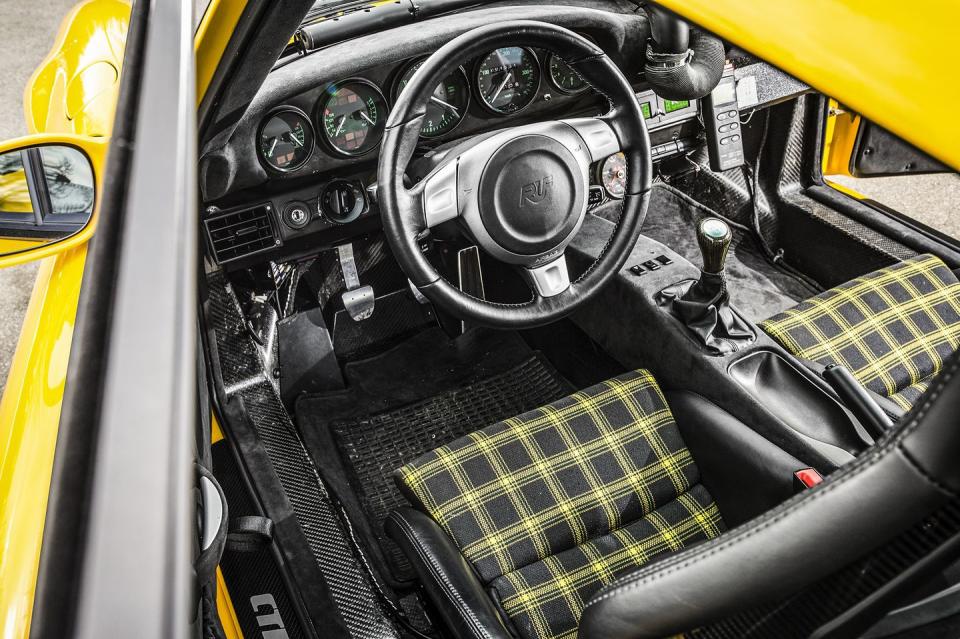
From the outside, the new one has less visible flare but seems wide as a bus by comparison. Its interior is a mishmash of exposed control boxes and neatly clamped wiring, like the guts of a military airplane. The adjustable steering column, lifted from a 997-generation 911, has no cosmetic trim. The button for the standard traction control is temporarily zip-tied to the dash. Almost everything is Alcantara-covered or bare carbon, and obviously unfinished.
On the road, the car is an odd mix of familiar sensations: The hollow-boned, whole-body resonance that carbon cars give over bumps; the tiny pillars and close dash of a 993; a sound like the Bird, with the same sing-songy rip but more manicured yowl at the top of the tach. Low rpm gives zero hiccups but a whiff of turbo lag-enough to make the car feel beasty but not require any special treatment.
I get maybe an hour at the wheel, a mix of town and autobahn, mostly with Ruf as passenger. He reminds me, repeatedly, that the CTR is a prototype. He doesn’t like the pedals, wants to tweak the suspension tune. He asks that Salt not photograph the unfinished engine bay, so “as not to be prejudged.”
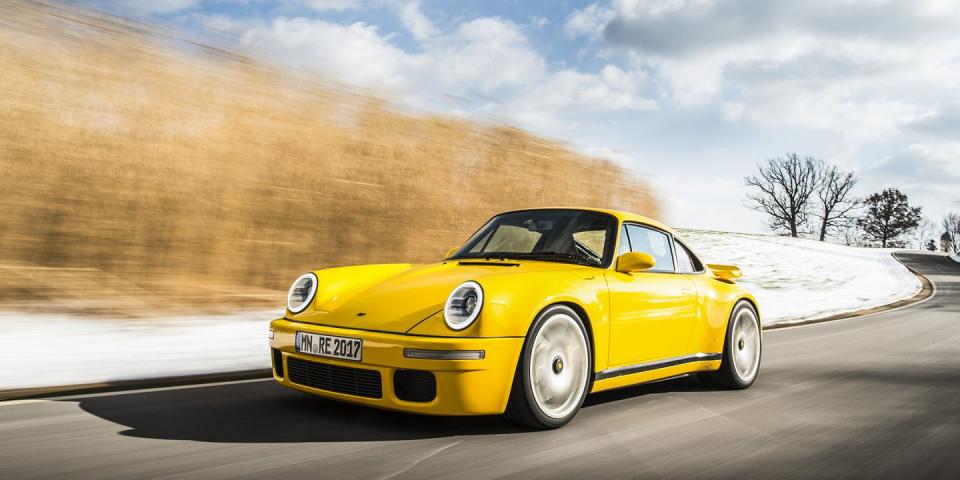
We head onto the autobahn, eyeblink blats to 150 mph between patches of traffic. Ruf is silent until clear road, at which point he waves a hand and gives an insistent, “Go, go, go.”
The CTR currently uses an experimental seven-speed manual that may not see production. Seventh is a practical gear, low enough to help highway pull. I barely touch it on the autobahn, hanging out instead in the lower gears. Toeing the throttle on boost makes the cockpit echo with a kind of whistling-air death noise, intake honk outshouting the exhaust and bouncing off the uninsulated carbon roof.
The prototype is far faster than the Bird, though the calmer chassis of the new car makes it feel less manic. The minimal lag of its engine can also lull you into forgetting its explosive potential, an approach that is mirrored by the rest of the car. The hydraulically assisted steering is nicely light at low speed but a little dry on feel. Same for the suspension, which can seem stiff-need and a shade overdamped while cruising around. But if you lean into it, Ruf's prototype grows fluid and limber, both involving and ferociously transparent.
“I want the car to be part of you,” he says. “An extension of your jeans. And to be this way without all the electronic gadgets, pure and honest, no filtering.”
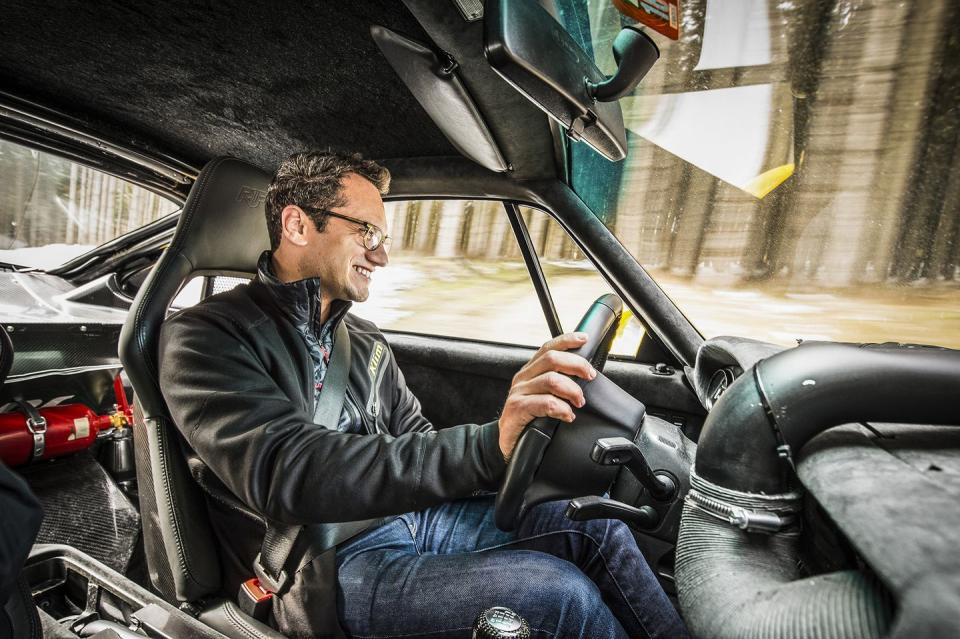
In 1987, a car’s top speed was an immediate, practical gauge of its engineering. In 2018, that number is beyond irrelevant. The world’s fastest cars are now so potent as to share little with ordinary passenger machines. Autobahns are so crowded that even an ’87 CTR is hard-pressed to show its full talent; the current production-car speed king, the 278-mph Koenigsegg Agera RS, will likely never demonstrate that number in public. Even if it does, the majority of humanity is now more interested in whatever Elon Musk is doing than in which oligarch special sits at the tip of the tech spear.
The layout is the funny part. On paper, a carbon-fiber machine shaped like an air-cooled 911 seems both impossible future and past-stuck backward-think. But maybe, decades from now, as major carmakers grow more occupied with automation and sexless mobility solutions, Ruf’s blueprint will be something of a way forward. Maybe it will presage a way forward with more affordable iron-we’ll re-create old loves as a skein of personality over hyperevolved tech, chasing feel above all.
That view is undeniably optimistic. But then, so is a tiny family company tooling up to build something like the new CTR. The car represents one of the things I’ve always loved about Ruf’s work, and about this business in general-the notion that the possible is rarely defined by the rules we know. The kind of emotional momentum that you can’t measure or pop into a spreadsheet. It’s a vision. And all the better for it.
('You Might Also Like',)

 Yahoo Autos
Yahoo Autos 